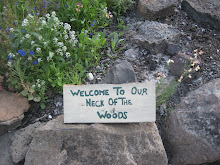The other day I heard from this person whom claims to know more then most......I have never claimed that but I was happy to find out that I actually knew something he was clueless about.To me Vanilla has never been a spice, it has been a flavoring. I started making my own vanilla a few years back and wanted to know what the vanilla tree or bush looked like.........it was a flower. That made sense to me but I was shocked to learn that not just any flower but that Vanilla was in the Orchid family. I thought for sure it would look more like an avocado tree with it's big flowers. I later found this little story on the www from the books of UCLA and I loved it, not to long but full of fun facts if you are a foodie like me!
Vanilla (Vanilla planifolia)
ORCHIDACEAE, Orchid Family
Vanilla (Vanilla planifolia) is a tropical, herbaceous vine, an orchid, that is native to the humid coastal rain forest of Central America and possibly to northern South America. Vanilla now occurs in the wild in the West Indies, where is may have been introduced. In the wild a plant is commonly 10-15 meters long, but in cultivation plants are kept shorter for easier handling. Adventitious roots produced along the stem permit the vine to cling to a tree.
Vanilla was first introduced to Europeans in 1520, when Diaz, an officer of Cortes, noted its use by the Aztecs in southern Mexico to flavor their chocolatl (Montezuma was served chocolatl in golden goblets!). By the end of the 16th century, the Spaniards had established factories to manufacture chocolate with vanilla flavoring, and for many years the Spaniards had control of vanilla production. A plant was successfully grown in England in 1807. From this, plant cuttings were given to botanical gardens in Paris and Antwerp. In 1819, two vanilla plants were sent to Java from Antwerp, and one survived but did not fruit. Finally in 1827, a plant from Paris was taken to Mauritius that did survive and fruit, giving rise to the vanilla industry centered around the Indian Ocean. Madagascar, which received a plant in 1840, now produces 90% of all the natural vanilla extract in the world. Vanilla can be cultivated around the world in the tropics wherever mean temperatures range between 21 and 32 degrees C.
Vanilla is typically planted with coffee, cashews, avocados, and other tropical tree crops. The relatively large, beautiful flowers later form long "beans" (capsular fruits), but this occurs naturally only in the New World. As it turns out, a special bee or hummingbird is needed to cross pollinate this orchid, so vanilla flowers in the Old World must be hand pollinated. This was first discovered by a Belgian botanist in 1836, and an effective production method was invented by a former slave on Madagascar in 1841 (Edmond Albius and his bamboo splinter), which was then introduced by Charles Morren. This is an expensive method; therefore, vanilla production requires inexpensive labor.
When the capsules are still immature and green, they are harvested in the early morning, spread on woolen blankets in the sun all morning, and then midday wrapped in the blankets for fermentation. They are stored overnight in metal-lined, air-tight boxes. This sweating process continues for weeks, until a substance in the bean, a glucoside, is changed into vanillin because the glucose is removed and replaced with a hydrogen. Alternative methods include the use of warm-water scalding and ovens. Vanilla is typically extracted in 35% ethanol, and sugar or glycerin is added to preserve flavor and aroma. A kilogram of beans produces about 1.5 gallons of extract. About 170 chemicals have been isolated from vanilla extract. Imitation vanilla (vanillin) is manufactured either from clove oil (eugenol) or as a breakdown product of lignin from a conifer (e.g., spruce, Picea).
I hope you loved this as much as I did and I hope you now know....Vanilla is not a spice.
Ms. Foodie






No comments:
Post a Comment